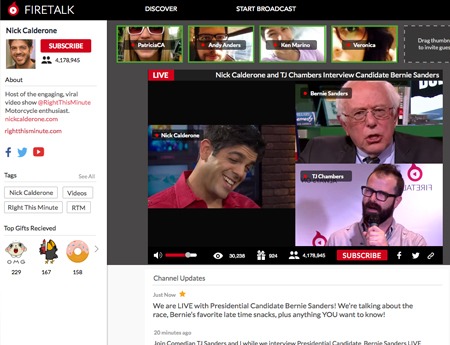Buttons Are in Style for Fall

Broadcasters have great hopes for ATSC 3.0, the next-generation broadcast standard that is expected to be finished in 2016. But for the moment at least, the race to reinvent broadcasting is so far being won by upstarts from the mobile world.
Five years ago, start-ups such as Ustream were touting their live-streaming mobile apps but stations were excitedly talking up prospects of mobile digital TV. For a mere $75,000-$150,000, stations could upgrade their transmission technologies and start broadcasting live TV signals directly to mobile devices.
Today, however, the much-hyped mobile DTV broadcast efforts are virtually dead and a host of live-streaming mobile apps are taking center stage. Much of the buzz has revolved around the launches this year of the Meerkat and Periscope apps, but there are a number of other players such as Hang w/and Firetalk, as well as older offerings from Ustream, Twitch, Bambuser, Google Hangouts on Air and others.
Some of the early offerings have ended up focusing on specific niches, with Twitch becoming a major player in live-streamed video games and Ustream becoming a more business-oriented platform. In April at the 2015 NAB Show, Ustream began working with JVC to allow users to live-stream from JVC cameras, which are widely used by broadcast stations in their news operations.
All of these apps, however, offer a new, greatly simplified form of broadcasting that is taking advantage of faster, more reliable mobile networks and the improved processing power of mobile devices.
THE IPHONE NETWORK
“The core idea is that we could democratize broadcast through a mobile app across the digital sphere,” said Mazen Alawar, marketing director of Hang w/. “That means the phone and the iPad quickly become both the production studio and the TV studio…A new media family is being developed with the mobile phone and second, third and fourth screens at the center of it.”
Broadcasting & Cable Newsletter
The smarter way to stay on top of broadcasting and cable industry. Sign up below
Those capabilities have already prompted a host of alliances between streaming apps and TV players. Since their launch earlier this year, Meerkat has already teamed up with the CMT Music Awards and with Discovery for Shark Week while Twitter’s Periscope has been used for the PGA Championship, various Univision events, The Ellen DeGeneres Show, The Voice and by Oxygen Media, VH1 and Lifetime.
“We have a ton of exciting things coming up for the fall season,” said Andrew Adashek, head of TV at Twitter.
Like all new media, however, this one poses some challenges and direct threats to traditional broadcasters and programmers. In the near term, their use to live-stream sports and movies has already raised copyright issues; in the long run, as mobile operators deploy 5G networks with much faster speeds, the improved quality of these streams could create a new generation of potential competitors for existing broadcasters.
For the moment, though, cooperation, not competition, is guiding most efforts. “We’re not really trying to replace anything that is out there,” said Rush Doshi, general manager of Firetalk, which launched at Vidcon in late July and is already in advanced talks with a number of channels and creators about using its platform. “We are trying to complement what they are doing. Because it is an interactive medium, we think there is an opportunity to bring people together for real-time interaction [between the audience and cast] and to make this notion of social TV, which has been talked about for years, more real than it has been in the past.”
LIVE REBOOT
One notable application is the fact that these apps provide a new tool for delivering live video over IP networks. A number of stations are already using them as a low-cost method for getting footage quickly on the air, or for their anchors and weather personalities to interact with audiences.
More fundamentally, they also open up opportunities for new types of storytelling that would involve multiple screens, said Alawar at Hang w/. “The way we think about TV programming is due for a refresh,” he added.
For example, Sima Sistani, VP of Media at Meerkat says, “I could see the development of a whole new class of reality-based content that people will not only watch voyeuristically on TV but participate and engage with.”
While much of the current focus has been on using live streams as a way to promote shows or engaging audiences with behind-the-scenes footage, these apps also open up new revenue opportunities.
These live-streaming efforts are being indirectly monetized through strengthening the value of larger sponsorship packages. “Brands and sponsors are already considering their impact,” said Twitter’s Adashek. “They expect to see Twitter integration. They expect to see more and more Periscope integration.”
Over time, the live streams could also open up new revenue opportunities in virtual currencies or subscriptions, added Alawar.
But like all new media, these efforts have to be carefully thought through. “You can’t just slap it on at the end and call it social TV,” Adashek said. “It has to be considered and baked into the show so that it is as much a part of the production as cameras and lighting.”










